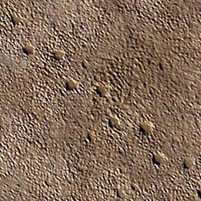Giga-Paleontology


Aerial view of a section of Mleisa 1 Trackway Site, U.A.E.
Two members of Carnegie Mellon University's Fine Outreach for Science Fellows program used the GigaPan-like photomosaic techniques promoted by the program to study the long trackway of a herd of prehistoric elephants.
The result: New insights into the social behavior of these creatures.
The footprints were left behind some 7 million years ago by at least 13 individual elephants and cover an area of more than 12 acres. The herd walked through mud and left footprints that hardened, were buried, and then re-exposed by erosion.
Analysis of trackway stride lengths reveals the herd contained a diversity of sizes — from adults to a young calf — making this the earliest direct evidence of social structure in prehistoric elephants ever discovered.
"Basically, this is fossilized behavior," said the lead author, Faysal Bibi. "This is an absolutely unique site, a really rare opportunity in the fossil record that lets you see animal behavior in a way you couldn't otherwise do with bones or teeth."
The findings were published Feb. 22 in the journal Biology Letters.
Bibi, of Museum fuer Naturkunde in Berlin, Germany, is a CMU Fine Fellow, as is one of his co-authors, Nathan Craig, assistant professor of anthropology at Penn State University.
Sponsored by the Fine Foundation, CMU's Fine Outreach program is part of the Robotics Institute's CREATE Lab. The program encourages leading scientists to use gigapixel imagery, such as that produced by the GigaPan system, as a scientific tool.
GigaPan was developed by CMU and NASA. Bibi and Craig met at a Fine workshop in Pittsburgh.
"The Fine Fellows Program was really the launchpad for this work," Bibi said. "It's really a great example of how this program, working to bring different specialists together, facilitates collaborations and promotes scientific output."
Their study site, known as Mleisa 1, is in the United Arab Emirates and is one of the largest trackway sites in the world. Though the site had been known for some time, it was only when the scientists photographed it from the air that its significance became clear.
Craig used a camera-mounted kite to take hundreds of aerial photos. Like the photos taken with the GigaPan system, these were then digitally stitched together to form a highly accurate photomosaic of the site.
"Once we saw it aerially, it became a much different and clearer story," said another co-author, Brian Kraatz of the Western University of Health Sciences. "Seeing the whole site in one shot meant we could finally understand what was happening."
Not only were the prehistoric elephants herding, but the same site indicates they also differentiated into solitary and social groups, and that these might have been sex-segregated just like in elephants today. In living elephants, adult females lead the herds while males disperse at sexual maturity and come back only to mate; such behavior is also suggested at the Mleisa 1 site.
Related Links: School of Computer Science | GigaPan.org | Fine Outreach for Science Fellows Program
